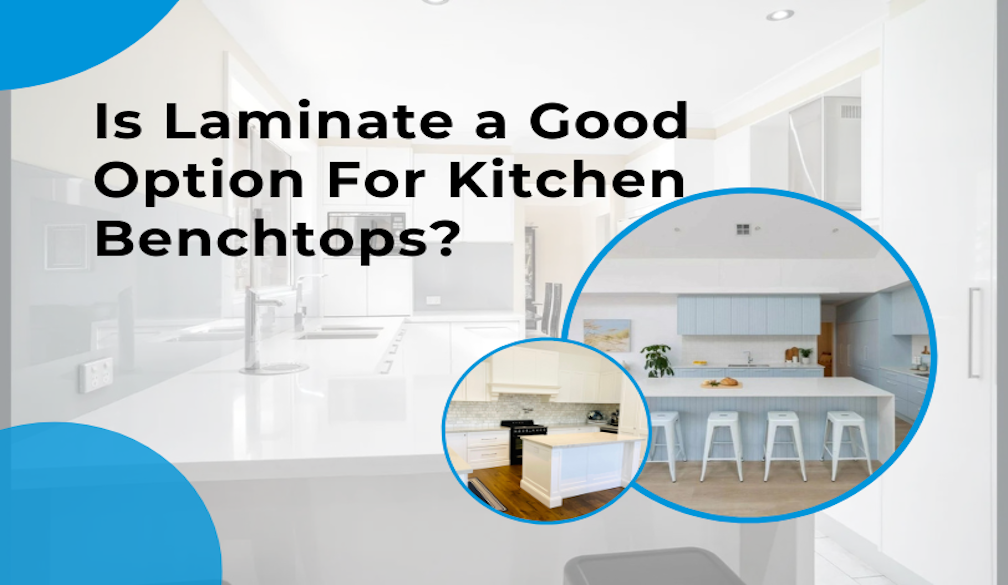Is Laminate a Good Option For Kitchen Benchtops?

When it comes to renovating your kitchen, one of the most important choices you’ll make is your benchtop material. It’s not just about looks, your benchtop needs to withstand daily use, match your style, and fit your budget. Among the many options available today, laminate benchtops have become a popular choice for homeowners across Australia. But is laminate really a good option for your kitchen? Let’s explore everything you need to know.
What is Laminate?
Laminate benchtops are made by layering sheets of paper or fabric with resin, then bonding them to a particleboard or MDF base. The result is a durable, decorative surface that can mimic the look of timber, stone, or even concrete at a fraction of the cost. Modern laminates have come a long way from the plastic-covered boards of the past. Today, they offer sleek finishes, realistic textures, and even edge options that make them look more premium than ever.
Advantages of Laminate Benchtops
Cost-Effective
One of the biggest draws of laminate is its affordability. While natural stone or engineered quartz can cost hundreds of dollars per square metre, laminate provides a stylish, functional alternative without breaking the budget. This makes it particularly appealing for first-time homeowners, renters, or those doing a kitchen renovation on a tight budget.
Wide Range of Colours and Designs
Laminate benchtops are available in an almost endless array of colours, patterns, and finishes. Whether you’re after a classic white, a marble-effect, or a bold, contemporary colour, there’s likely a laminate option to suit your kitchen. This versatility also makes it easier to coordinate with your cabinets, flooring, and overall kitchen theme.
Low Maintenance
Unlike timber or natural stone, laminate doesn’t require sealing, polishing, or specialised cleaners. A simple wipe-down with warm, soapy water is usually enough to keep it looking fresh. For busy households, this low-maintenance feature can be a game-changer.
Lightweight and Easy to Install
Laminate is lighter than stone or solid surfaces, making installation quicker and often cheaper. If you’re doing a DIY renovation or want to reduce labour costs, laminate can be a more manageable option.
Considerations Before Choosing Laminate
Durability and Scratch Resistance
While laminate is reasonably tough, it isn’t as scratch-resistant as stone or quartz. Knives, heavy pans, or abrasive cleaners can damage the surface over time. Using chopping boards and avoiding harsh cleaning products can help extend its lifespan.
Heat and Moisture Sensitivity
Laminate is more vulnerable to heat and moisture compared to stone surfaces. Placing hot pots or pans directly on the benchtop can cause burns or warping. Similarly, standing water near seams can damage the core material if left unchecked.
Long-Term Lifespan
Laminate is durable, but it generally won’t last as long as granite, quartz, or solid timber. While a well-maintained laminate benchtop can last 10–20 years, other materials may last a lifetime if properly cared for.
Laminate vs Other Popular Benchtop Materials
When comparing laminate to granite, quartz, or timber, a few key differences stand out:
- Granite and Quartz: Extremely durable, heat-resistant, and scratch-proof, but expensive.
- Timber: Warm and natural, can be sanded and refinished, but requires regular sealing and care.
- Laminate: Affordable, low-maintenance, and highly versatile in style, but less heat and scratch-resistant.
For many homeowners, laminate offers the perfect balance of style, practicality, and cost—especially for everyday kitchens or rental properties.
Design Tips for Laminate Benchtops
Choosing Colours and Patterns
Consider the overall look you want for your kitchen. Light colours can make a smaller space feel larger, while darker patterns add a touch of sophistication. Marble or concrete-look laminates are particularly popular in modern Australian kitchens.
Coordinating with Cabinets and Flooring
Laminate works well with almost any cabinet style, from classic timber to contemporary high-gloss finishes. Match or contrast your benchtop with your cabinets and flooring to create a cohesive look.
Creative Uses in Small Kitchens
Laminate’s versatility makes it ideal for small kitchens. You can create a continuous surface that extends into breakfast bars or islands without worrying about heavy stone slabs.
Maintenance and Care Tips
- Regular Cleaning: Wipe spills promptly with a damp cloth and mild detergent. Avoid harsh chemicals.
- Heat Protection: Use trivets or heat pads for hot pots and pans.
- Prevent Scratches: Always use chopping boards; avoid dragging heavy items across the surface.
- Minor Repairs: Small scratches can sometimes be buffed out, and edge damage can be repaired with matching laminate patches.
Who Should Consider Laminate Benchtops?
Laminate is a great choice for:
- Budget-Conscious Homeowners: Offers style without a high price tag.
- Busy Families: Easy to clean and maintain with kids in the house.
- Rental Properties: Durable enough to handle regular use while remaining affordable to replace.
- Home Renovations:Ideal for kitchens needing a fresh, modern look without a major investment.
Conclusion
Laminate benchtops have come a long way in recent years, offering style, practicality, and affordability for a wide range of kitchen designs. While they may not match the durability of stone or timber, they provide an excellent balance of aesthetics and functionality, especially for families, renters, and budget-conscious homeowners.
If you’re considering a kitchen renovation and aren’t sure which benchtop material is right for your home, it’s worth weighing the pros and cons carefully. And just like choosing the right kitchen surface, making upgrades to your home’s essentials like power systems or appliances should be handled with care. Talk to a licensed professional to get the right advice, ask the right questions, and ensure your kitchen is both stylish and functional for years to come.















